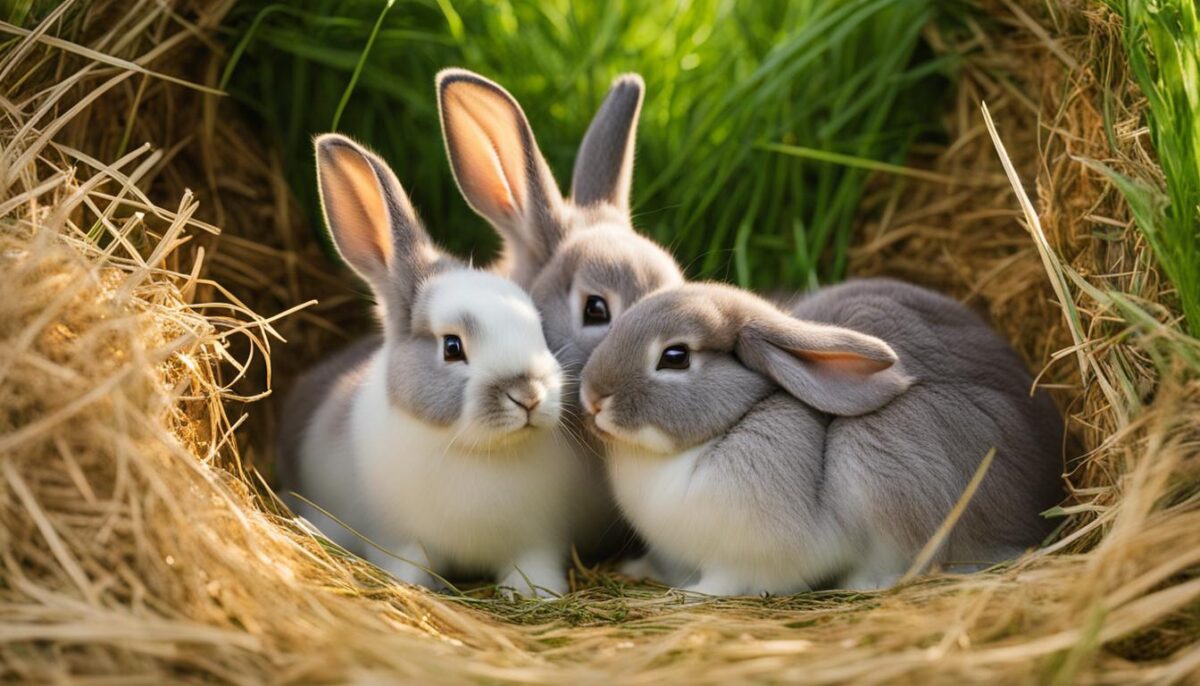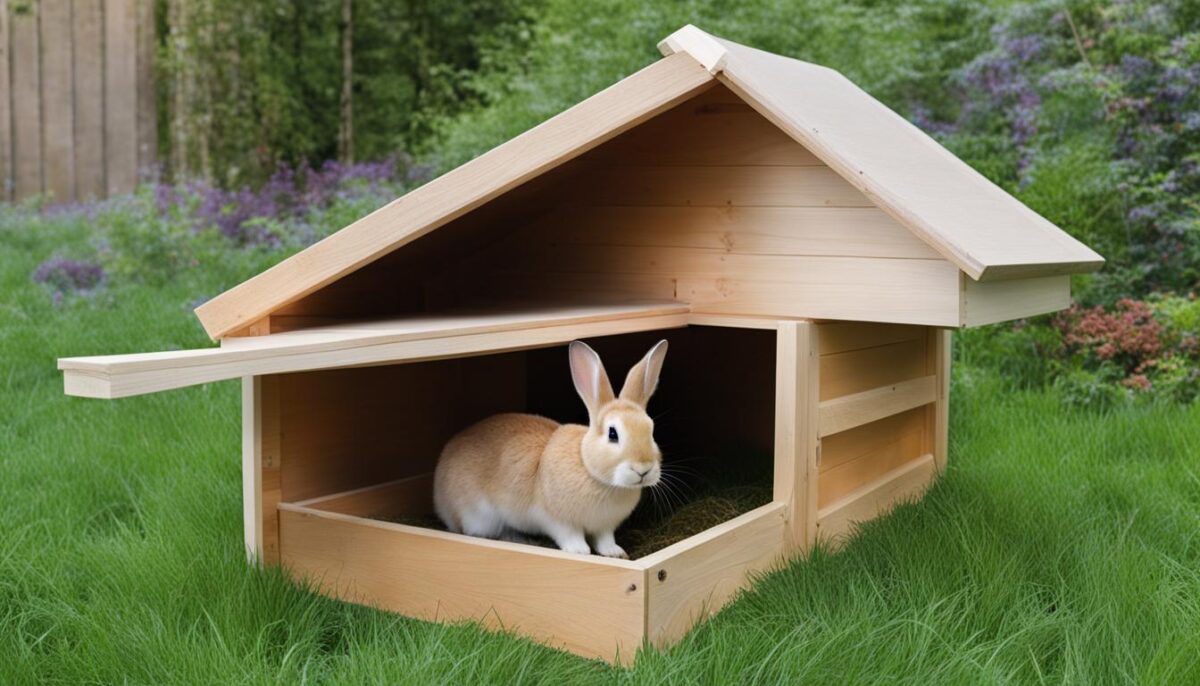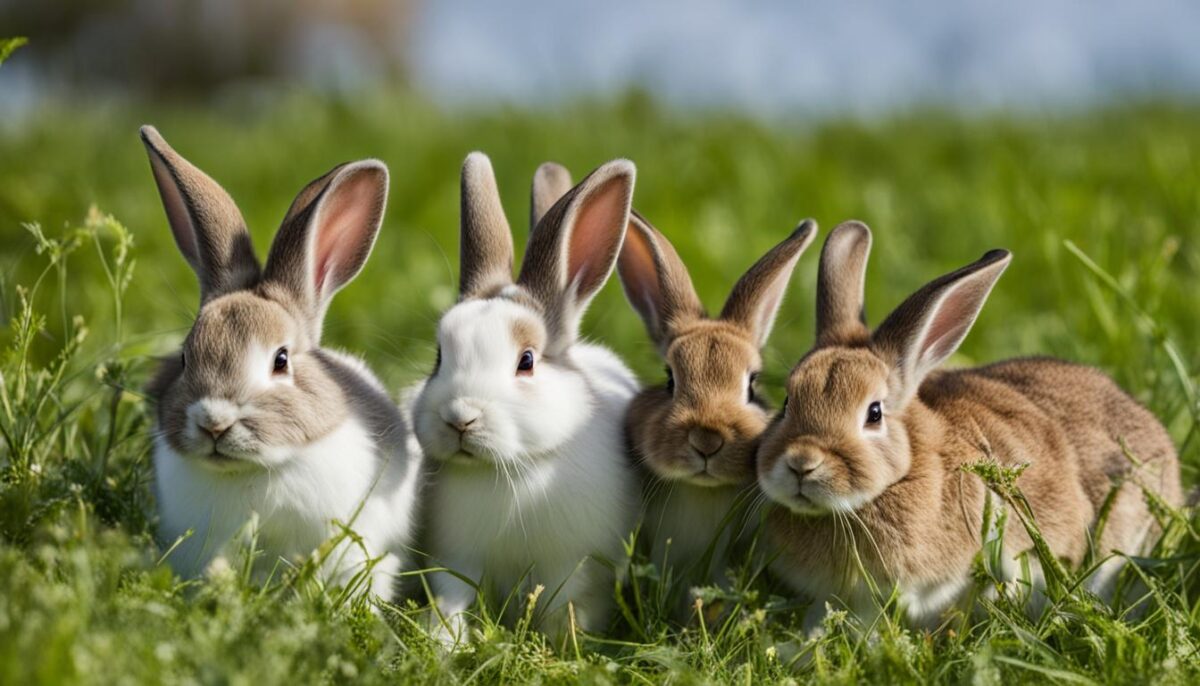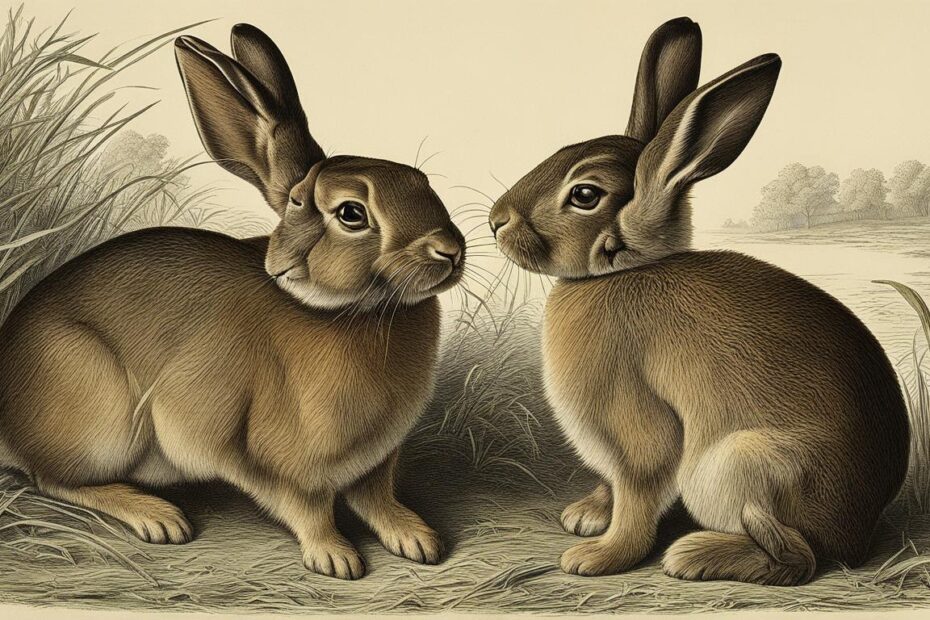Rabbits are fascinating creatures when it comes to reproduction. From their unique mating behavior to the nesting and birthing process, understanding how rabbits have babies is essential for their well-being and successful breeding practices. In this comprehensive guide, we will delve into the rabbit breeding process, providing valuable insights into their reproductive cycle, nesting habits, and the care required for healthy kits. Whether you are a rabbit enthusiast or considering rabbit farming for commercial purposes, this guide will equip you with the knowledge needed to ensure the welfare and successful reproduction of these adorable creatures.
Key Takeaways:
- Understanding rabbit mating behavior and the reproductive cycle is crucial for successful breeding.
- Rabbits create nests lined with their fur to give birth to their kits and nurse them once a day.
- Proper handling, weaning, and feeding of kits are important for their growth and development.
- Separating the male rabbit and neutering both males and females help prevent unwanted pregnancies and improve overall health.
- Clean housing, regular check-ups, and preventive measures are essential for the well-being of rabbits.
How Rabbits Have Babies
The Mating Behavior of Rabbits
Rabbits have a fascinating mating behavior that sets them apart from many other animals. Unlike species that have specific breeding seasons, female rabbits, or does, can accept male rabbits, or bucks, at any time of the year. This means that rabbits are not limited to a particular reproductive cycle, giving them greater flexibility in breeding. Does can start breeding at around 5 to 6 months of age and can continue to have young for up to 4 years.
To ensure successful breeding, it is important to understand the reproductive cycle of rabbits. The gestation period for rabbits is approximately 31 days, with does giving birth to litters that can vary in size from 1 to 12 kits. It is generally advisable to mate the doe when her previous litter reaches 4 weeks of age. This spacing allows the kits to be 8 weeks old when the next litter is born, ensuring that the mother has enough time to care for her young while maintaining her own health.rabbit reproduction
It’s important to note that male rabbits should be separated from the does to prevent fighting. Additionally, rabbits are “induced ovulators,” meaning that the act of mating stimulates ovulation and increases the chances of pregnancy. This unique characteristic of rabbits’ reproductive system emphasizes the importance of allowing the rabbits to mate when they are together to ensure successful breeding.
| Key Points | Rabbit Mating Behavior |
|---|---|
| Age of breeding | 5-6 months for does |
| Gestation period | Approximately 31 days |
| Litter size | 1-12 kits |
| Recommended breeding spacing | Mating when previous litter reaches 4 weeks of age |
| Male-female separation | Important to prevent fighting |
| Mating behavior | Induced ovulation |
Nesting and Birthing Process
During the nesting and birthing process, female rabbits, or does, create a cozy nest to give birth. They line the nest with their fur, creating a soft and warm environment for the arrival of their kits. The mother rabbit typically gives birth inside the nest, where the kits are born with their eyes and ears sealed shut and without fur. This delicate stage is crucial for the survival and development of the kits. bunny reproduction
The mother rabbit feeds her kits once a day, usually for 5 to 10 minutes. This short period of nursing provides the kits with their daily milk supply. Surprisingly, the mother’s preferred time for nursing is between midnight and 5:00 a.m., making her a night owl caretaker. Her rich milk sustains the babies for a full 24 hours, providing the necessary nutrients for their growth.rabbit birthing
It is essential to allow the mother rabbit to take care of her babies without interference. The mother rabbit rarely abandons or ignores her young, so intervention is usually unnecessary. However, checking the nest a couple of days after the kits are born can help ensure their health and well-being. By doing so, you can make sure all the kits are alive and thriving.
The Nesting and Birthing Process in a Nutshell:
- Female rabbits create a nest using their fur to give birth.
- The kits are born with their eyes and ears sealed shut and without fur.
- The mother rabbit feeds her kits once a day, usually between midnight and 5:00 a.m.
- Checking the nest a couple of days after birth can help ensure the health of the kits.
Allowing the mother rabbit to care for her babies and only providing support when necessary ensures a smooth nesting and birthing process. The mother rabbit’s nurturing instincts and the kits’ rapid development contribute to their successful growth and survival.
Bunny Reproduction: Handling and Weaning of Kits
When it comes to handling and weaning rabbit kits, it’s important to follow proper procedures to ensure their health and development. Shortly after birth, kits should not be handled immediately, as they are delicate and dependent on their mother for warmth and nourishment. However, it is safe to check the nest a couple of days later to ensure all the kits are alive and well. Distract the mother rabbit with treats or play while gently inspecting the nest. Remember to re-cover the nest after checking, as the mother rabbit has carefully created it for her kits’ protection.rabbit pregnancy stages
At around three weeks old, the kits will start nibbling on solid food and produce, and they will also begin eating their caecotrophs, which are special night poos. It is during this time that they become more independent and less reliant on their mother’s milk. By the time they reach six to eight weeks old, the kits can be separated from their mother. However, it is essential to gradually reduce the number of kits with the mother to allow her body to adjust and avoid mastitis, which is inflammation of the mammary glands.

Table: Recommended Handling and Weaning Timeline for Rabbit Kits
| Age of Kits | Handling and Weaning Practices |
|---|---|
| Immediately after birth | Avoid handling kits to ensure their safety and warmth. |
| A couple of days old | Check nest under the mother’s supervision. Re-cover the nest after inspection. |
| Around three weeks old | Kits start nibbling on solid food. Continue nursing from mother. |
| Six to eight weeks old | Kits can be separated from the mother. Gradually reduce the number of kits with the mother. |
By following these guidelines for handling and weaning rabbit kits, you can ensure their smooth transition into independent, healthy rabbits. Remember to provide them with a balanced diet as they transition to solid food, and monitor their growth and development closely. It is a fascinating process to watch these little kits grow and thrive, and with the right care, they will become happy, well-adjusted adult rabbits. rabbit reproductive cycle
Rabbit Breeding and Desexing: Important Considerations for Responsible Rabbit Ownership
When it comes to rabbit breeding, there are several important factors to consider to ensure the health and well-being of your rabbits. Before deciding to breed your rabbits, it’s crucial to have a clear understanding of the responsibilities involved and the potential consequences of uncontrolled breeding. Additionally, desexing your rabbits plays a significant role in preventing unwanted pregnancies and promoting their overall physical and mental health.
Responsible rabbit breeding involves careful planning and consideration of various factors, such as the age and health of the rabbits, suitable housing, and proper feeding. Breeding rabbits should only be done when you have a suitable home or market for the offspring, as overcrowding and the inability to find appropriate homes can lead to neglect and abandonment. It’s essential to research and understand the specific breed’s breeding patterns and the gestation period to ensure you provide the necessary care for the mother and her kits.
Desexing, also known as spaying or neutering, is a critical step in preventing unwanted pregnancies and improving the overall health of your rabbits. Female rabbits, or does, are prone to uterine cancer, which can be prevented by spaying them. Male rabbits, or bucks, can exhibit aggressive behavior and territorial marking if not neutered. Neutering both male and female rabbits also eliminates the risk of genetic diseases and reduces the urge to escape in search of mates, promoting a more peaceful and stress-free environment for your rabbits.
By taking these responsible steps in rabbit breeding and desexing, you contribute to the welfare of your rabbits and the larger rabbit community. It is crucial to consult with a veterinarian who specializes in rabbit care and breeding to ensure you receive accurate information and guidance throughout this process. Remember, being a responsible rabbit owner means understanding the responsibilities that come with breeding and making informed decisions to prioritize the health and well-being of your rabbits.
Feeding and Watering Rabbits
Proper nutrition and hydration are essential for the health and well-being of rabbits. Providing a balanced diet and ensuring access to clean water are crucial aspects of rabbit care. Here’s a closer look at rabbit feeding, watering, and nutrition.how do bunnies reproduce
Rabbit Feeding
Rabbits have specific dietary requirements that need to be met to keep them healthy. While ready-mixed rabbit feed pellets are available and provide a convenient option, it’s also important to supplement their diet with fresh vegetables. Carrots, sugar beet, parsnip, and green leaves can be given to rabbits, providing them with essential vitamins and minerals.
Grains such as oats, wheat, barley, and maize, as well as dry bread, can also be included in their diet. However, it’s crucial to avoid overfeeding grains, as they have a high carbohydrate content that can cause obesity and other health issues. Providing hay daily is also essential, as it serves as both bedding and a source of constant access to food. Hay promotes healthy digestion and helps wear down a rabbit’s continuously growing teeth.
Rabbit Watering
Water is vital for rabbits, and it should be supplied at all times. A suitable water drinker, such as a plastic bottle with a spout, can be attached to the rabbit’s enclosure to ensure access to clean water. Rabbits drink a significant amount of water, especially during hot weather, so it’s essential to regularly monitor and refill their water supply to prevent dehydration.
Nutritional Considerations
When it comes to rabbit nutrition, it’s important to strike the right balance. Overfeeding can lead to obesity and related health issues, while underfeeding can result in malnutrition and poor growth. Monitoring a rabbit’s weight and body condition score, consulting with a veterinarian, and adjusting their diet accordingly can help ensure they receive appropriate nutrition and maintain a healthy weight.

In addition to housing, it’s important to provide rabbits with a suitable environment for nesting. Rabbits are known to exhibit nesting behaviors by digging burrows or creating nests in the wild. Providing them with materials such as straw, hay, or shredded paper can encourage these natural instincts and provide them with a cozy and secure place to rest and sleep. Ensuring their nesting area is warm, quiet, and free from excessive disturbances is essential for their comfort and well-being.
Uses of Rabbits and Disease Prevention
Rabbits have multiple uses beyond their reproductive capabilities. Their meat is considered of good quality and can be consumed by humans. In addition, their long hair can be collected and spun into wool for clothing, providing warmth and comfort. Rabbit skins can also be dried and treated to create pelts that can be used for various purposes, such as making hats or accessories.
Another benefit of rabbits is their droppings, which make excellent fertilizer due to their high nutrient content. Rabbit manure is rich in nitrogen, phosphorus, and potassium, making it a valuable organic fertilizer for gardens and crops. By using rabbit manure, farmers can improve soil fertility naturally and reduce the need for synthetic fertilizers.
“Rabbit manure is one of the best all-purpose fertilizers for most plants. It can be applied to vegetables, flowers, and fruit trees.”
When it comes to disease prevention, ensuring proper care and hygiene for rabbits is essential. Regular veterinary check-ups and vaccinations help safeguard their health and detect any potential issues early on. Additionally, providing a clean living environment, balanced nutrition, and access to fresh water play a crucial role in preventing diseases.
| Common Rabbit Diseases | Prevention and Care Tips |
|---|---|
| 1. Viral Hemorrhagic Disease (VHD) | – Vaccinate rabbits against VHD – Maintain strict hygiene practices – Isolate sick rabbits from healthy ones |
| 2. Myxomatosis | – Vaccinate rabbits against myxomatosis – Control the rabbit flea population – Prevent contact with wild rabbits |
| 3. Pasteurellosis | – Keep rabbits in clean and well-ventilated housing – Provide a balanced diet to boost their immune system – Promptly treat any respiratory infections |
| 4. Coccidiosis | – Maintain clean living conditions and remove feces regularly – Provide a balanced and diverse diet – Administer coccidiosis prevention medication as advised by a veterinarian |
Recognizing signs of illness is crucial for early intervention. Some common indicators of rabbit illness include dull eyes, rough coat, diarrhea, teeth grinding, or a sudden change in behavior. If any of these symptoms are observed, it is important to consult a veterinarian promptly for proper diagnosis and treatment.

Rabbit Care Tips:
- Provide a clean and well-ventilated living environment for rabbits.
- Ensure rabbits have a balanced diet, including hay, pellets, and fresh vegetables.
- Regularly clean and disinfect food and water dishes to prevent bacterial growth.
- Handle rabbits gently and avoid stressful situations to promote their well-being.
- Monitor rabbits for any signs of illness and seek veterinary care when necessary.
- Prevent the spread of parasites and infections by practicing good hygiene and sanitation.
- Keep rabbits protected from extreme temperatures and provide shelter from harsh weather conditions.
In conclusion, rabbits have various uses, from their meat and fur to their droppings. Disease prevention plays a crucial role in ensuring the health and well-being of rabbits. By implementing proper care practices, maintaining a clean environment, and recognizing signs of illness, rabbit owners can help their furry companions live happy and healthy lives.
Breeding and Feeding for Commercial Purposes
In addition to their natural reproduction process, rabbits can also be bred and raised for commercial purposes. Commercial rabbit farming involves the intentional breeding of rabbits to produce meat, wool, pelts, and even fertilizer. With proper care and feeding, a single male rabbit and two females can produce over 50 rabbits in a year, which can be sold or consumed.
To start a successful commercial rabbit farm, it is important to provide suitable housing for the rabbits. A small wooden house or hutch is sufficient for a male rabbit, but larger hutches or multi-level cages may be necessary to accommodate multiple breeding pairs. The housing should be clean, dry, and well-ventilated to ensure the health and well-being of the rabbits.
Feeding the rabbits a balanced diet is crucial for their growth and productivity. Ready-mixed rabbit feed pellets made from grains, plants, minerals, and vitamins are readily available and provide the necessary nutrients for the rabbits. In addition to pellets, vegetables such as carrots, sugar beet, parsnip, and green leaves can be included in their diet. Grains like oats, wheat, barley, and maize, as well as dry bread, can also be offered as part of their feeding regimen.
| Feeding Recommendations for Commercial Rabbit Farming |
|---|
| Provide ready-mixed rabbit feed pellets as the main source of nutrition |
| Include vegetables such as carrots, sugar beet, parsnip, and green leaves in their diet |
| Offer grains like oats, wheat, barley, and maize, as well as dry bread |
| Ensure a constant supply of clean and fresh water |
| Provide hay daily for bedding and as a source of constant access to food |
Maintaining clean and well-ventilated housing is essential to prevent the occurrence and spread of diseases among rabbits. Regular veterinary check-ups and vaccinations are also important to keep the rabbits in optimal health. It is equally important to recognize signs of illness or distress in the rabbits, such as dull eyes, rough coat, diarrhea, or teeth grinding, and take appropriate action to address any health issues. By providing the necessary care, nutrition, and attention to hygiene, commercial rabbit farming can be a rewarding venture.
Conclusion
In conclusion, understanding how rabbits have babies is vital for their well-being and successful breeding practices. Female rabbits, or does, can have multiple litters per year, with each litter consisting of several kits. It’s important to provide proper care and monitoring of the nest and kits to ensure their health and development.
Separating the male rabbit and neutering both the male and female rabbits is highly recommended to prevent unwanted pregnancies and improve their overall health. Feeding a balanced diet and providing clean housing and nesting boxes are essential for the growth and development of the rabbits.
Recognizing signs of illness and practicing preventive measures are crucial to maintaining the health of rabbits. Whether for personal enjoyment or commercial purposes, understanding the unique reproductive process of rabbits is key to their welfare and successful breeding practices.
FAQ
How many babies can a rabbit have?
A rabbit doe can have 3-8 babies, with an average litter size of 7.
How many litters can a rabbit have in a breeding season?
Rabbits can have about five litters per breeding season.
How long is the gestation period for rabbits?
The gestation period for rabbits is around thirty days.
How long do rabbits stay in the nest?
Kits leave the nest after about two weeks.
How often do mother rabbits nurse their kits?
Mother rabbits nurse their kits once every 12-24 hours.
When do female rabbits start breeding?
Female rabbits can start breeding at around 5 to 6 months of age.
How many kits can a doe have per litter?
Does can produce anywhere from 1 to 12 kits per litter.
How long should you wait to breed a doe after she gives birth?
It is better to mate a doe when her previous litter reaches 4 weeks of age.
How often should a male rabbit be separated from the does?
Male rabbits should be separated from the does to prevent fighting.
How often should rabbits be fed?
Rabbit kits rely on their mother’s milk for the first few weeks, while adult rabbits should be fed daily.
What should rabbits be fed?
Rabbits can be fed ready-mixed rabbit feed pellets made from grain, plants, minerals, and vitamins, as well as vegetables and grains.
How should rabbits be housed?
Rabbits should be housed in clean, dry, and well-ventilated hutches or housing.
What are the uses of rabbits?
Rabbits can be raised for meat, their fur can be spun into wool, and their droppings make excellent fertilizer.
Why is neutering important for rabbits?
Neutering prevents unwanted pregnancies, reduces the risk of certain health issues, and helps rabbits coexist without sexual frustration.
How can diseases be prevented in rabbits?
Providing good feeding and clean housing, regular veterinary check-ups, vaccinations, and practicing proper handling and hygiene can help prevent diseases in rabbits.
How many rabbits can be produced for commercial purposes?
With proper care, one male rabbit and two females can produce over 50 rabbits in a year.


